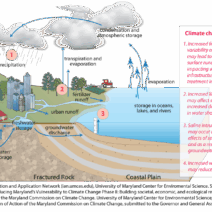As we embark on an exploration of a topic that intersects science with our daily existence, one might wonder: how profound is the footprint of climate change on our health? Might it only be a backdrop for natural disasters and extreme weather, or is there a more insidious connection that permeates our very well-being? Unbeknownst to many, the implications of our changing climate extend far beyond rising temperatures; they seep into the realms of public health, influence chronic disease prevalence, and modify our social circumstances. This article delves into the myriad ways climate change impacts human health, revealing surprising connections that underscore the urgency of addressing this global crisis.
As climate change accelerates, we witness a slew of environmental transformations—melting glaciers, more erratic weather patterns, and unpredictable seasons. This poses a critical challenge to our health, serving as a catalyst for various diseases and health issues previously relegated to more stable climates. For instance, vector-borne diseases, such as malaria and dengue, flourish under changing conditions. The proliferation of mosquitoes in warmer climates and their subsequent range expansion mean that diseases once confined to specific geographic locations are now making their unwelcome appearance in new territories.
Next, consider the intricate relationship between air quality and climate. Rising temperatures contribute to the formation of ground-level ozone, a hazardous pollutant with deleterious effects on respiratory health. As the climate warms, increased emissions from vehicles and industries, coupled with stagnant air conditions, can elevate ozone levels, exacerbating asthma and other respiratory ailments. The elderly, children, and those with pre-existing health conditions are particularly vulnerable, underscoring an urgent need for policy action aimed at curbing emissions.
Moreover, the physical manifestations of climate change extend to food security and nutrition. Unpredictable weather patterns disrupt agricultural outputs, leading to food scarcity in certain regions while enticing the proliferation of invasive plant species. Such shifts adversely affect the availability and quality of food, leading to an increase in malnutrition and foodborne diseases. Furthermore, the rise in carbon dioxide levels can diminish the nutritional value of staple crops, directly impacting the dietary sufficiency of populations worldwide.
As we navigate through these unfolding scenarios, we must also confront the psychosocial ramifications of climate change. The anxiety and stress stemming from extreme weather events—be it hurricanes, floods, or prolonged droughts—can precipitate mental health crises. Communities affected by climate disasters often experience an uptick in conditions such as depression and post-traumatic stress disorder (PTSD). In this context, the mental toll of climate change becomes as significant as the physical health risks.
Moreover, let us not overlook the socio-economic factors intertwined with climate change. Marginalized communities bear the brunt of environmental degradation, exacerbating health disparities. Limited access to healthcare, precarious living conditions, and lower resilience to climate impacts put these populations at an even greater risk for adverse health outcomes. The synergy between climate change and social inequities necessitates a comprehensive approach to public health that considers not only environmental factors but also socio-political elements.
With these complex health implications in mind, one may wonder what proactive measures are being undertaken to address such multifaceted challenges. The intersection of climate and health has ignited a global discourse advocating for sustainable practices—green infrastructure, clean energy innovations, and climate-resilient healthcare systems. These initiatives present a formidable opportunity to assuage the adverse impacts of climate change while promoting public health.
One particularly promising avenue is the emphasis on urban green spaces, which serve as buffers against heat, improve air quality, and foster community well-being. Increasing tree coverage not only enhances the aesthetic appeal of urban areas but also mitigates heat islands. Such spaces can act as havens, reducing stress and promoting physical activity—an essential aspect of public health.
Furthermore, a shift towards sustainable agricultural practices equips farmers to adapt to changing climatic conditions while ensuring food security. Techniques such as crop rotation, organic farming, and agroforestry can enhance ecosystem resilience and offset some of the negative health impacts associated with climate change.
As we look towards the future, the narrative around climate change and health must evolve from one of passive observation to active participation. Each individual plays a pivotal role in mitigating the effects of this global crisis through conscious decisions regarding consumption, waste, and energy use. As communities unite to advocate for systemic change, the collective power of the populace can drive policymakers toward implementing effective interventions.
In conclusion, the relationship between climate change and human health is both intricate and profound. It presents a formidable challenge but also an opportunity for transformative action. The interplay of environmental factors on health outcomes serves as a crucial reminder of our interconnectedness with the planet. As the climate crisis intensifies, so too must our resolve to advocate for sustainable solutions that protect not only our environment but also our collective health and well-being. It is imperative that we approach this challenge not with fear but with fortitude and an unwavering commitment to a healthier future.

